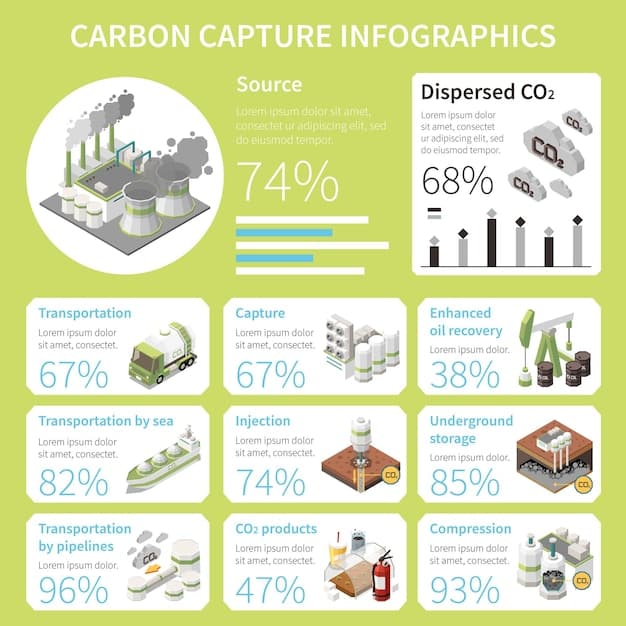Carbon Capture: A Key to US Climate Goals by 2050?

Carbon capture and storage (CCS) is poised to play a crucial role in the United States’ efforts to meet its climate goals by 2050 by capturing CO2 emissions and storing them underground, reducing their impact on the atmosphere and contributing to emissions reduction targets.
The United States has ambitious climate goals, aiming for a significant reduction in greenhouse gas emissions by 2050. But how will the US achieve this goal? Carbon capture and storage (CCS) technologies are a key component of many strategies, holding the potential to capture carbon dioxide emissions from power plants and industrial facilities, preventing them from entering the atmosphere.
Understanding Carbon Capture and Storage (CCS)
Carbon capture and storage, often abbreviated as CCS, is a process designed to prevent carbon dioxide (CO2) from entering the atmosphere. As the US aims to meet its ambitious 2050 climate goals, understanding CCS becomes increasingly important.
The core concept involves capturing CO2 from industrial sources, such as power plants and cement factories, transporting the captured CO2, and then securely storing it underground to prevent its release into the atmosphere, helping to mitigate climate change.
The Three Main Stages of CCS
CCS consists of three critical stages that must be effectively implemented in order to achieve its climate goals.
- Capture: Separating CO2 from other gases produced by industrial processes.
- Transport: Moving the captured CO2 via pipelines or other means to a storage location.
- Storage: Injecting the CO2 deep underground into geological formations for long-term storage.
Each of these stages requires specialized equipment, techniques, and infrastructure to ensure the safe and efficient removal and storage of CO2.
In conclusion, CCS is a promising technology with the potential to significantly reduce carbon emissions from major sources. By understanding the stages and applications of CCS, the US can better leverage this technology in its fight against climate change.
The Potential of CCS in Meeting US Climate Goals
The potential of CCS in helping the US meet its climate goals by 2050 is substantial, though not without its challenges. As the nation seeks to drastically reduce its carbon footprint, CCS emerges as a critical tool.
By preventing emissions from entering the atmosphere, CCS can help bridge the gap between current emissions levels and the ambitious reduction targets set by the government. CCS complements other strategies such as renewable energy deployment and energy efficiency improvements, ensuring a well-rounded approach to decarbonization.
Reducing Industrial Emissions
Industrial facilities like power plants, cement factories, and refineries are significant contributors to greenhouse gas emissions. CCS technology can be used to capture CO2 emissions at these sites.
- Retrofitting existing power plants with CCS systems.
- Designing new industrial facilities with integrated CCS technology.
- Utilizing CCS in industries that are difficult to decarbonize, such as cement and steel production.
The application of CCS in these industries can significantly reduce their carbon footprint and contribute to overall emissions reduction targets.

In summary, the potential of CCS in meeting US climate goals is significant, but harnessing this potential requires investment, innovation, and political support.
Current CCS Projects and Infrastructure in the US
The United States has been actively developing CCS projects and infrastructure, signaling a commitment to leveraging this technology for climate mitigation.
These projects span various industries and regions, aiming to demonstrate the feasibility and scalability of CCS technologies.
Examples of Current CCS Projects
Several CCS projects are currently operating or under development across the United States.
The Petra Nova project in Texas was one of the early large-scale CCS demonstrations, retrofitting a coal-fired power plant to capture CO2. While the project faced some operational challenges, it provided valuable insights into the practical application of CCS.
- The Illinois Industrial Carbon Capture and Storage Project.
- The Archer Daniels Midland (ADM) CCS project in Illinois.
- Numerous smaller-scale pilot projects
These projects are instrumental in refining CCS technologies and building confidence in their long-term viability.
In conclusion, the current CCS projects and infrastructure in the US showcase the nation’s commitment to developing and deploying carbon capture and storage technologies.
Challenges and Opportunities for CCS Deployment
While CCS holds immense potential, its widespread deployment faces several technical, economic, and regulatory challenges. However, overcoming these challenges presents significant opportunities for innovation and growth.
Addressing these challenges is essential for CCS to play a meaningful role in meeting US climate goals.
One of the primary challenges is the high cost associated with capturing, transporting, and storing CO2. The economic viability of CCS relies on government incentives, carbon pricing mechanisms, and technological advancements that reduce costs.
Overcoming Challenges, Seizing Opportunities
Addressing the challenges of CCS deployment requires a multifaceted approach.
- Government funding and tax incentives to support CCS projects.
- Establishing clear and consistent regulations.
- Investing in R&D to improve CCS technologies.
By addressing these challenges and seizing these opportunities, the US can pave the way for widespread CCS deployment.

In summary, while CCS deployment faces significant challenges, addressing these obstacles presents substantial opportunities for technological innovation, economic growth, and environmental stewardship.
The Role of Policy and Incentives in Advancing CCS
Government policies and financial incentives play a crucial role in driving the advancement of CCS technologies and projects within the United States. Without supportive policies, the widespread adoption of CCS is unlikely to occur.
These policies can take various forms, including tax credits, grants, regulations, and carbon pricing mechanisms, each designed to encourage investment in CCS and reduce its economic barriers.
Tax credits, such as the 45Q tax credit in the US, provide financial incentives for capturing and storing CO2. They reduce the project’s overall cost, making it more attractive to investors and developers.
Effective Policies and Incentives
To effectively advance the use of CCS, it needs support from reliable policies and incetives.
- Offering direct funding and grants to CCS projects.
- Implementing carbon pricing mechanisms.
- Streamlining the permitting process for CCS projects.
By implementing these effective policies and incentives, governments can create a favorable environment for CCS deployment, driving down emissions and supporting climate goals.
In conclusion, supportive government policies and financial incentives are essential for driving the advancement and deployment of CCS technologies.
Future Outlook: CCS and the Path to Net-Zero Emissions
Looking ahead, CCS is expected to play an increasingly important role in the global effort to achieve net-zero emissions. As countries strive to decarbonize their economies, CCS offers a solution for addressing emissions from hard-to-abate sectors.
The future of CCS involves continued innovation, cost reductions, and scaling up of projects to achieve significant emissions reductions globally.
As technologies like direct air capture (DAC) become more viable, CCS may also play a role in removing existing CO2 from the atmosphere.
Innovations: DAC + CCS
Combining Direct Air Capture with CCS technology can bring great innovation to the net-zero emissions goal.
- DAC facilities can be located anywhere, allowing for the removal of CO2 from ambient air.
- Advancements in materials science and engineering.
- Increasing deployment of CCS technologies worldwide.
These factors will contribute to the long-term success of CCS in mitigating climate change.
| Key Point | Brief Description |
|---|---|
| 🏭 CCS Definition | Capture, transport, and store CO2 from industrial sources. |
| 🎯 US Climate Goals | CCS can significantly aid in meeting emissions reduction targets by 2050. |
| 💰 Costs & Policies | Policy support and financial incentives are crucial for CCS viability. |
| 🌱 Future Outlook | Includes innovations like DAC and continued global deployment. |
en-US]
What is carbon capture and storage (CCS)?
▼
CCS involves capturing CO2 from sources like power plants, transporting it via pipelines, and storing it deep underground to prevent atmospheric release.
What role will CCS play in meeting US climate goals?
▼
CCS can significantly reduce emissions from industrial facilities, helping to meet ambitious greenhouse gas reduction targets and complementing renewable energy efforts.
What are the main challenges facing CCS deployment?
▼
High costs, technological hurdles, regulatory complexities, and public perception all pose challenges to the widespread adoption of carbon capture and storage technologies.
What incentives are in place to encourage CCS projects in the US?
▼
The 45Q tax credit and other government policies offer financial incentives for CCS projects, aiming to make them more economically viable and attractive to investors.
How does CCS contribute to a net-zero emissions future?
▼
CCS addresses emissions from hard-to-abate industries and, when combined with technologies like DAC, can help remove existing CO2, supporting the transition to net-zero emissions.
Carbon capture and storage technologies offer a promising avenue for the US to meet its climate goals by 2050. While challenges remain, ongoing innovation, supportive policies, and strategic deployment can unlock CCS’s full potential. By investing in CCS, the United States can achieve important emissions reductions and promote a more sustainable energy future.
Read more content

